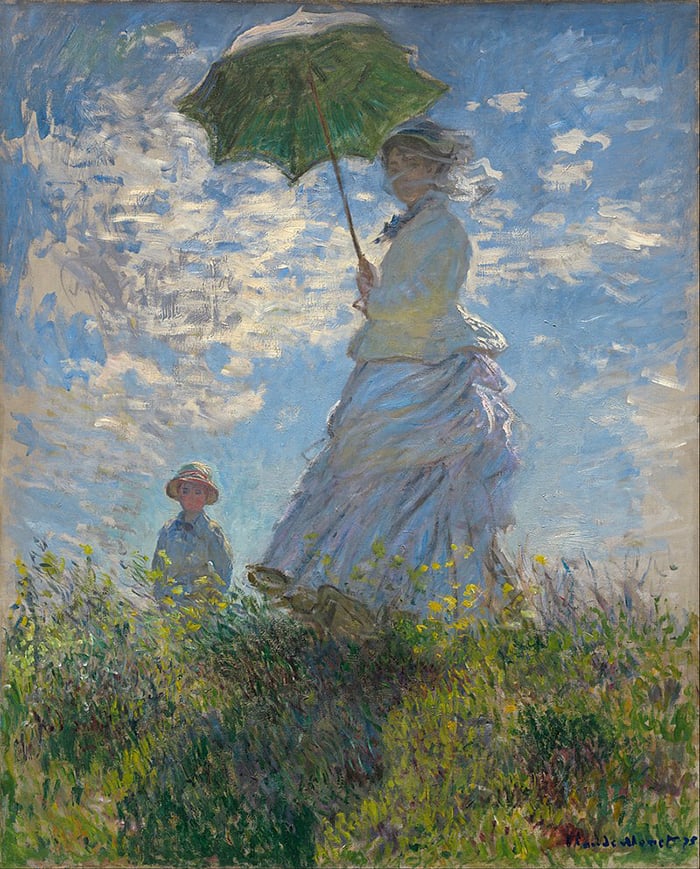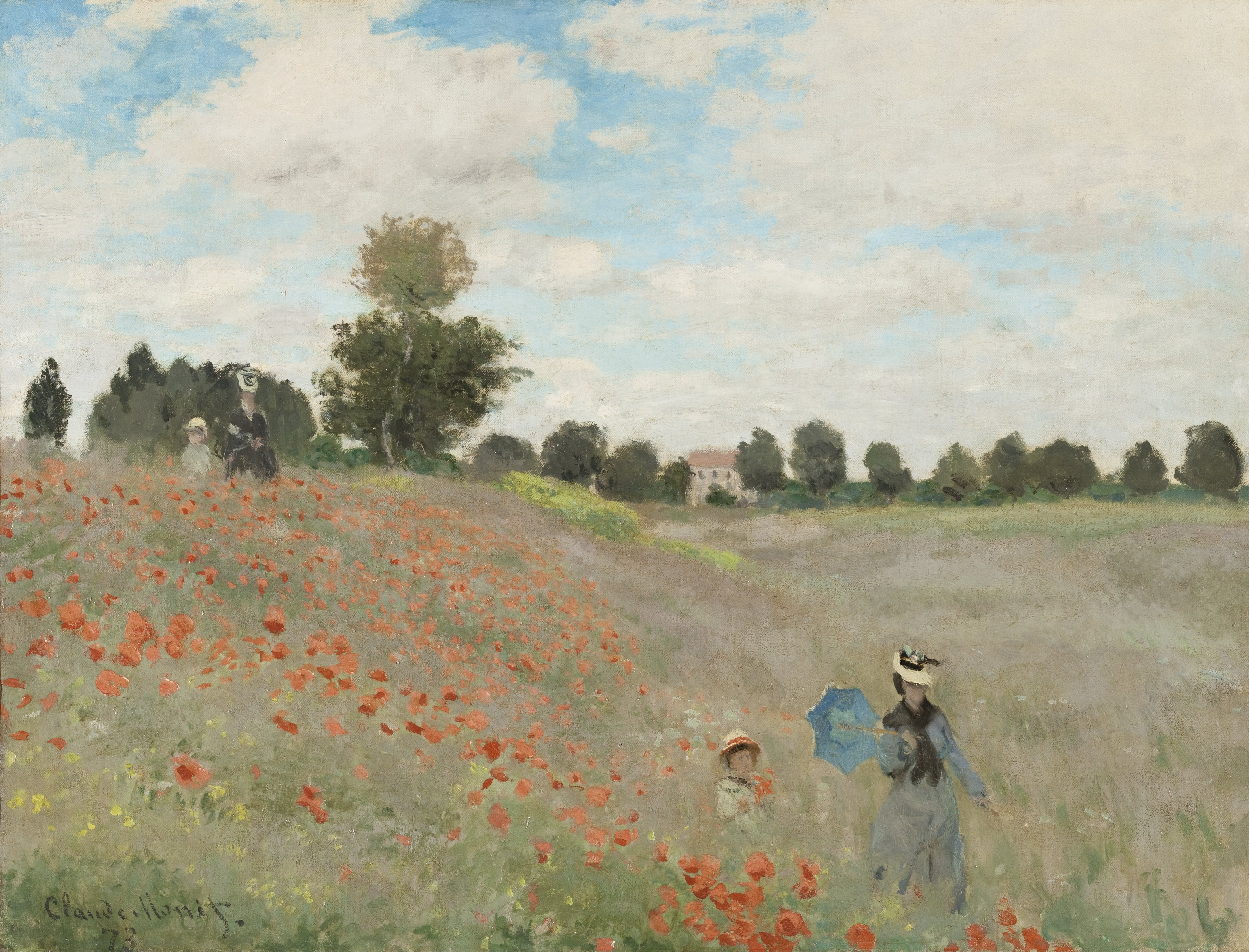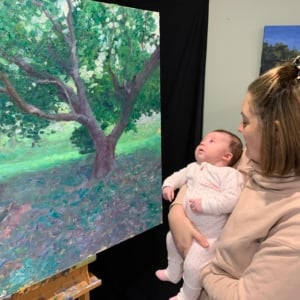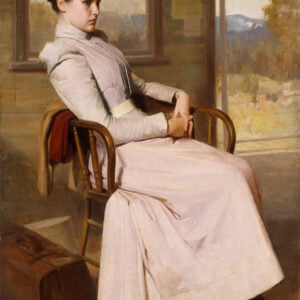Let’s take a closer look at Woman With a Parasol by Claude Monet. This painting embodies Impressionism and Monet’s work. A fleeting moment captured with light colors and fresh strokes.
I’ll cover:
- Key Facts and Ideas
- Movement and Brushwork
- Color and Light
- Composition
- Key Takeaways
- Additional Resources
- Want to Learn More?
- Thanks for Reading!

(You can download a high-resolution version of the painting here. You get to see Monet’s strokes with remarkable clarity.)
Key Facts and Ideas
- The painting depicts Monet’s first wife Camille and son Jean strolling through Argenteuil.
- It’s a large painting, coming in at 39 x 32 inches. Monet’s largest from the 1870s. It must be a magnificent sight in person.
- It was painted plein air (outdoors) perhaps within a single session, according to the National Gallery of Art. This would explain the painting’s intimate and spontaneous feel.
- It was one of Monet’s 18 paintings featured in the second Impressionist exhibition, 1876. John Singer Sargent saw it at the exhibition and was inspired to paint Two Girls with Parasols at Fladbury.

- Monet painted two similar works about 10 years later: Woman With a Parasol, Facing Left and Woman With a Parasol, Facing Right. This time featuring Suzanne Monet, his second wife’s daughter.


Movement and Brushwork
The painting features typical Monet brushwork: broken color, energetic strokes, and simplified detail. It’s effective for capturing a fleeting moment like this. It looks fresh and spontaneous, not staged.
Camille turns to see us, with her dress twisting around her body. There’s movement in this pose. Monet’s brushwork follows the contours of the dress. The child, on the other hand, appears more static. No twists or turns. This further accentuates Camille’s movement by contrast. If you want more examples of how to paint the body’s movement, check out Edgar Degas’ dancer paintings.
Monet used simple and flat brushwork for the faces. See the close-ups below. But, the details he did use are accurate. Simple doesn’t mean sloppy.


It looks like a windy day. The sky is full of energy and movement. Below is a close-up of Monet’s brushwork. Look at the variance in his strokes. Thick, thin, different directions, white, gray, blue, light, dark.

For the grass, Monet used short, jabby strokes. This gives a more erratic appearance. But, notice how the grass follows a broad movement with the wind.

A good exercise for analyzing a painting is to map out the path your eyes take through the painting. You can do this in your head; no need to draw anything physically. Where does the painting take you? You might find it reveals subtle links between otherwise distinct areas in the painting. In this case, movement connects the dress, grass, and sky.
Color and Light
The painting features an Impressionist palette of blues, greens, yellows, and a few red accents. The lights are bright and the shadows are colorful. Instead of using blacks and browns for shadows like the Old Masters, Monet and the Impressionists preferred greens, blues, reds, and purples. They chose color at the sacrifice of deep shadows.
There appears to be a general theme of thick lights, thin shadows. Notice the thick lights in the sky for the clouds and the highlights on Camille’s dress (see below). Compare this to the relatively thin color used for the faces and other shadows. The closeup below also shows reflected light hitting around the underside of her arm. This is yellow-green light bouncing up from the grassy foreground. A subtle yet important touch by Monet.

Monet relied on broken color to create the illusion of detail and movement. The sky has all kinds of blues, grays, and whites. The foreground has yellows, blues, greens, and purples.
Below is a grayscale of the painting. It’s a lot darker than you might expect. Rich, saturated colors tend to appear lighter than they really are. It’s easy to confuse highly saturated colors as being light colors. But remember, colors tend to be at their strongest around the middle of the value scale. I go into more detail on this in my Painting Academy course.

Composition
Monet painted from a low vantage point, looking up at Camille. His child is further back, around eye-level. This creates an interesting play in terms of perspective and space. The low vantage point also gives dominance to the sky.
In terms of focal points, my eyes are drawn towards Camille’s face first, then the child’s face, even though they are both simplified. That’s the power of facial features. We are programmed to look for them.
With that being said, the two figures are fairly balanced against the dramatic surrounding nature. It’s an unusual painting in this sense: it’s not a pure portrait, and it’s not a pure landscape. It’s a hybrid of both. If the woman and child were farther in the distance, it would be a landscape. The Poppy Field comes to mind. If Camille were closer and more rendered, it would be a portrait.

Let’s look at the painting in terms of the rule of thirds. The idea behind the rule of thirds is that the grid lines and intersections are considered aesthetically pleasing areas. Below is the painting with a three-by-three grid over the top (using my grid tool) plus some key observations:
- The foreground comes to the bottom horizontal line.
- Camille’s face is around the top right intersection. The child is around the bottom-left intersection.
- Camille’s back lines up with the right verticle line.
- The clouds are strongest around the top-left intersection.

To learn more about composition, you might be interested in my Composition Breakdown course.
Key Takeaways
- Consider the connection between your painting style and the nature of the subject. Monet’s Impressionist style was effective in capturing this fleeting and intimate moment.
- You can create the illusion of movement with clever brushwork and broken color. Let your brush follow contours and mimic the subject’s movement.
- Try to match the nature of your brushwork to the nature of the subject. Monet used sweeping, energetic brushwork for the sky; short, jabbing brushwork for the foreground; and flat brushwork for the two faces.
- Is there an overarching theme you can follow in your painting? Monet followed a theme of thick lights, thin shadows.
- Don’t mistake color saturation for value. Highly saturated, rich, or vivid colors can appear lighter than they really are.
- Closeups of paintings reveal important clues about how it was painted.
- We are programmed to look for certain things in life, such as eyes and facial features. In this case, I am drawn towards the two faces in the painting despite them being so simplified.
Additional Resources
- More A Closer Look Posts
- How to Paint like Claude Monet
- Painting Academy
- Landscape Painting Masterclass
Want to Learn More?
You might be interested in my Painting Academy course. I’ll walk you through the time-tested fundamentals of painting. It’s perfect for absolute beginner to intermediate painters.
Thanks for Reading!
I appreciate you taking the time to read this post and I hope you found it helpful. Feel free to share it with friends.
Happy painting!
Dan Scott

Draw Paint Academy







Great learning! it has shown true light on painting techniques and brushing the skills!
Thanks..
Really great analysis foe me. It helps to actually understand examples examples of how artists have used the rules you read about. Thanks. Domor
Loved this post. You described everything in such detail and opened my eyes, great lesson. Thank you.
Brilliant and helpful article….thank you so much. Beautiful painting.
thanks for writing this informative article
Thanks so much for the great study!
Have been playing with light myself, mainly animals in their environment (weather changes) and the sheen on skin, Feathers, grass etc.
Just love Degas’s “Dancing Class” with the cheval mirror. Monet is a huge mentor with his use of outdoor light and I so admire the simplicity of ‘less is more’.
Although I never had any training in art, I have always loved to paint but I have always attempted perfection. These impressionist paintings you have been showing us are amazing, especially with your great explanations. I have always loved these paintings as they are so alive with movement and after reading your articles I am encouraged to attempt this style to see what happens. Keep up the good work.
Excellent, Dan. I always look forward to receiving your material.
So serene to the eye yet so complex in interpretation. Thank you for such an understandable interpretation.
Your comments and observations are so full of inspiration to EXAMINE pictures to obtain the real details.
Thank you
David
A really helpful explanation thank you. Would this style be possible with acrylics?
Thanks Dan, you find so much in this painting to point out and share with us. It’s so interesting.
Dan: The punch of color, the thrill of impressionism is such a huge appetite to get going. Yet the sketch settles me down looking at something that fills my head and I want it. Keep reminding me of the basics as I keep growing. Thanks,
Bob Durocher
Thanks for this, Dan. As always a good guide to help us look at this painting.
I was distracted by what looks like a trophy (maybe two) behind the clouds above the boy’s head. Is it an underpainting, or am I over-imagining it?
While I have had some art training and I am aware of the various styles Impressionism, Expressionism, Cubism, I have not had enough practice in rendering any. I know there is much more room for improving and linking my brushwork with the themes of my paintings and the capturing of light and movement. I really like your analysis of this simple Money painting. It is really an eye opener about capturing brushwork, composition and movement on canvas.
Very good Dan, I enjoy these insights and analysis, thank you
Thank you Dan for being so generous with your lessons and insights.
As a gift, may I share with everyone a little symphony of colors.
Thanks Dan.
Your posts brighten up the day.
I loved this post. So clear and understandable. I’ve always loved this painting.
An engrossing essay Dan; thank you so much for sharing your knowledge and experience so freely here. Reading this has been pleasurable and enriching.
A wonderful way to start this day with color, light, movement and energy.
If your classes are anything like the knowledge given in your posts, it is money well spent. Monet has always been one of my favorites but it is discouraging to look at his paintings because I see so much beauty that I don’t think I can ever achieve in a painting.
Thank you! I always look forward to reading your posts.
Thank you for this info! I do believe I finally, after looking at impressionist work, get the idea! Monet is my favorite, but I’ve never quite grasped how the impressionist artists created the effects they produced. I’m truly looking forward to applying what I learned from your post here.
Fantastic information and so interesting all the facts relating to how he achieved the effects of light shadow and movements and the technique in his applied brushstrokes
Love these paintings and how your eye is drawn into the the figures but then wants to follow the motion captured in sky clothes and grass very beautiful
The more you look the more you see
Thankyou so much hope I can achieve some of these qualities
You chose my very favorite painting by my very favorite artist! I am looking at the beautiful poster I purchased at the national Museum when they hosted the Impressionists show many years ago. It was wonderful reading your commentary- you made my day. Thank you!!
I remember seeing this painting at the National Gallery. There are many great paintings there, but on that day, this was the painting that stuck with me and took my breath away!
Your topic of conversation is divine. Monet is my favorite. Thank you for bringing all these observations to our attention.
Thank you! I always look forward to reading your posts.
Thank you Dan. I always enjoy your posts and I’m so impressed you do it all for free. Look forward to the next one already.
Thank you, very much appreciate your insight.
Thank you. I appreciate the time and detailed explanations you put into your posts.
I love the impressionist period and Monet and Manet were above all else. My only other love was the pointillism of Seurat.
Cubism, modern or baroque is nothing to me.
This is one of my favorite Monet paintings. You have managed to point out things that I have missed for years. Well done!
Brilliant, Dan, that’s the only work to express your accurate, passionate and simplicity within complexity
I,ve seen it many years ago, and admiration superposed my analys.
Thank you so much.
Receive a warm abraço from this Brazilian Fan!
Wilson corrects
“…to express my gratitude….” the word gratitude, that is a key word was suppressed by mistake
Let s forget, you could not undersand
Thank you for taking us deeper into the complexity of a great artist’s simplicity.
I love this painting so much! I very much appreciate the light and color study of Monet in his painting! I sincerely enjoyed reading your article and I appreciate the straightforward approach!
Thank you so much!
THANKYOU so much… your posts are a lift in these strange times! Love your take on painting… I’m in a state of avoidance at the moment and am doing anything rather than paint…. 🙀🙀!
Have always admired Monet’s work and have a few prints, and many years ago visited his home and garden. Could you recommend a good reproduction of prints of his work? Thank you so much for your interpretation of his work.
So detailed and so helpful! Thank you so much!
I’ve seen this painting up close and I remember the wonderful feeling it invoked in me. Although I was always a bit confused by the movement of the wind implied. The hat ribbons going left to right and the bottom of the skirt going right to left with the grass.
Thank you, I love receiving your posts. Incredible insight to the masters. I love studying what you send through. I might even get the courage to start your course soon….
Thank you. As always an enjoyable and thought-provoking read
I so enjoy reading your viewpoint of each painting you present. I have always loved Monet’s paintings and appreciate the time you take interpreting his work with such insight and clarity and….sharing your thought with us. I am certainly adding to my Art History that I started in University. It’s like I have a private tutor! 🙂 Thanks again for sharing.
One of my granddaughters sent me an email and wondered if I would do a painting for her and that
she liked Monet. The first one I saw was “Woman with umbrella”. So glad to see that one as I did it many years ago for someone else and thoroughly enjoyed it. She is sending me pictures that she like
and for me to paint the one I liked and would enjoy painting. This is the one!
It was so informative to read this analysis of mo net’s painting. Thank you so much. I learned several really important things.
Again many thanks.
Thank you very much for sharing Monet’s paintings by explaining details etc.
I’m studying Art to try and paint myself. I have taken a couple of classes, but photography is my passion, by taking the photos, photoshop and printing for our local art exhibitions. I will continue reading your posts.
Hi Dan,
I’m interested in figurative painting.
I read your “A Closer Look at Woman With a Parasol by Claude Monet”.
Do you offer any courses in this subject?
Please let me know. Thank you kindly.
Hi Shoshana
I don’t have any courses on figure drawing or painting at this stage.
Possibly in the future.
Dan
This article was so helpful! I am an art major and one of my final projects is called the Master Copy. The painting I chose to copy was Monet’s Lady with a Parasol. Your article was very helpful in analyzing the painting. Keep up the great work!